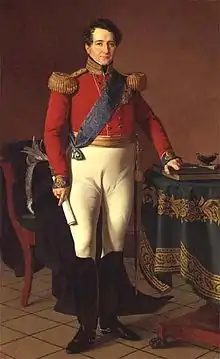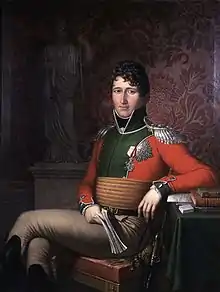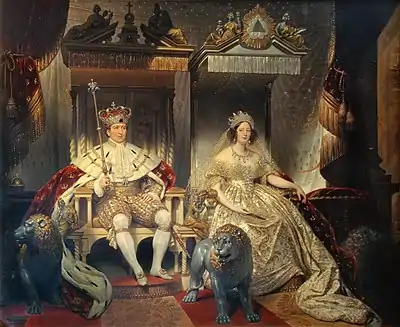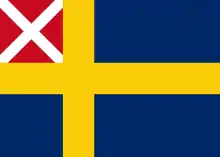Christian VIII of Denmark
Christian VIII (18 September 1786 – 20 January 1848) was the king of Denmark from 1839 to 1848 and, as Christian Frederick, King of Norway in 1814.[1]
| Christian VIII | |||||
|---|---|---|---|---|---|
 Portrait by Louis Aumont, 1831 | |||||
| King of Denmark (more...) | |||||
| Reign | 3 December 1839 – 20 January 1848 | ||||
| Coronation | 28 June 1840 Frederiksborg Palace Chapel | ||||
| Predecessor | Frederick VI | ||||
| Successor | Frederick VII | ||||
| King of Norway | |||||
| Reign | 17 May – 10 October 1814 | ||||
| Predecessor | Frederick VI | ||||
| Successor | Charles II | ||||
| Born | 18 September 1786 Christiansborg Palace, Copenhagen | ||||
| Died | 20 January 1848 (aged 61) Amalienborg Palace, Copenhagen | ||||
| Burial | |||||
| Spouse | Charlotte Frederica of Mecklenburg-Schwerin Caroline Amalie of Schleswig-Holstein-Sonderborg-Augustenburg | ||||
| Issue | Frederick VII of Denmark | ||||
| |||||
| House | Oldenburg | ||||
| Father | Frederick, Hereditary Prince of Denmark | ||||
| Mother | Sophia Frederica of Mecklenburg-Schwerin | ||||
| Religion | Lutheranism | ||||
| Danish Royalty |
| House of Oldenburg Main Line |
|---|
.svg.png.webp) |
| Christian VIII |
|
Early years
Christian was born at Christiansborg Palace in Copenhagen. He was the eldest son of Hereditary Prince Frederick of Denmark and Norway and Duchess Sophia Frederica of Mecklenburg-Schwerin. His paternal grandparents were King Frederick V of Denmark-Norway and his second wife, Duchess Juliana Maria of Brunswick-Wolfenbüttel.
Christian's mother died in 1794 when he was eight years old, and his father died in 1805 when Christian was nineteen. His upbringing was marked by a thorough and broad-spectrum education with exposure to artists and scientists who were linked to his father's court. Christian inherited the talents of his highly gifted mother, and his amiability and handsome features are said to have made him very popular in Copenhagen.
Marriage
Christian first married his cousin Duchess Charlotte Frederica of Mecklenburg-Schwerin at Ludwigslust on 21 June 1806. Charlotte Frederica was a daughter of Friedrich Franz I, Grand Duke of Mecklenburg-Schwerin, and Princess Louise of Saxe-Gotha-Altenburg (1756-1808). His first-born son was Christian Frederik, who was born and died at Schloss Plön on 8 April 1807. His second son became Frederick VII of Denmark. The marriage was dissolved by divorce in 1810 after Charlotte Frederica was accused of adultery.[2]
Christian married his second wife, Princess Caroline Amalie of Schleswig-Holstein-Sonderburg-Augustenburg (daughter of Louise Augusta of Denmark, the only sister of Frederick VI) at Augustenborg Palace on 22 May 1815. The couple was childless and lived in comparative retirement as leaders of the literary and scientific society of Copenhagen until Christian ascended the throne of Denmark.[3]
Christian had ten extramarital children, for whom he carefully provided. It has been suggested that these extramarital children included the fairy tale author Hans Christian Andersen, though there is little evidence to support this.[4]
King of Norway

In May 1813, as the heir presumptive of the kingdoms of Denmark and Norway, Christian was sent as stattholder (the king's highest representative in Norway) to Norway to promote the loyalty of the Norwegians to the House of Oldenburg, which had been very badly shaken by the disastrous results of Frederick VI's adhesion to the falling fortunes of Napoleon I of France. Christian did all he could personally to strengthen the bonds between the Norwegians and the royal house of Denmark. Though his endeavours were opposed by the so-called Swedish party, which desired a dynastic union with Sweden, he placed himself at the head of the Norwegian party of independence after the Treaty of Kiel had forced the king to cede Norway to the king of Sweden. He was elected Regent of Norway by an assembly of notables on 16 February 1814.[5]
This election was confirmed by the Norwegian Constituent Assembly convoked at Eidsvoll on 10 April, and on 17 May the constitution was signed and Christian was unanimously elected king of Norway under the name Christian Frederick (Kristian Frederik in Norwegian). Christian next attempted to interest the great powers in Norway's cause, but without success. On being pressed by the commissioners of the allied powers to bring about a union between Norway and Sweden in accordance with the terms of the treaty of Kiel, and then return to Denmark, he replied that, as a constitutional king, he could do nothing without the consent of the parliament (Storting), which would not be convoked until there was a suspension of hostilities on the part of Sweden.[6]
Sweden refused Christian's conditions and a short military campaign ensued in which the Norwegian army was defeated by the forces of the Swedish crown prince Charles John. The brief war concluded with the Convention of Moss on 14 August 1814. By the terms of this treaty, King Christian Frederick transferred executive power to the Storting, then abdicated and returned to Denmark. The Storting in its turn adopted the constitutional amendments necessary to allow for a personal union with Sweden and on 4 November elected Charles XIII of Sweden as the new king of Norway.[7]
King of Denmark

On 3 December 1839 he ascended the Danish throne as Christian VIII. The Liberal party had high hopes of “the giver of constitutions.” However, by this time, Christian had become more conservative, and disappointed his admirers by steadily rejecting every Liberal project. Administrative reform was the only reform he would promise. In his attitude to the growing national unrest in the twin duchies of Schleswig and Holstein he often seemed hesitant and half-hearted, which damaged his position there. It was not until 1846 that he clearly supported the idea of Schleswig being a Danish area.[8]
King Christian VIII continued his predecessor's patronage of astronomy, awarding gold medals for the discovery of comets by telescope and financially supporting Heinrich Christian Schumacher with his publication of the scientific journal Astronomische Nachrichten. It was during his reign that the last remnants of Danish India, namely Tranquebar in the south and Serampore in Bengal, were sold to the British in 1845.
His only legitimate son, the future Frederick VII (1808–1863) was married three times, but produced no legitimate issue. Since he was apparently unlikely to beget heirs, Christian wished to avert a succession crisis. Christian commenced arrangements to secure the succession in Denmark. The result was the selection of the future Christian IX as hereditary prince, the choice made official by a new law enacted on 31 July 1853 after an international treaty made in London.
King Christian died of blood poisoning in Amalienborg Palace in 1848 and was interred in Roskilde Cathedral. Some historians and biographers believe that King Christian would have given Denmark a free constitution had he lived long enough; his last words are sometimes (rather tragically) recorded as "I didn't make it". (Jeg nåede det ikke) [9]
Honours
He received the following orders and decorations:[10]
 Denmark:[11]
Denmark:[11]
- Knight of the Elephant, 16 November 1787
- Cross of Honour of the Order of the Dannebrog, 10 August 1808
- Grand Commander of the Order of the Dannebrog, 28 October 1828
 Austrian Empire: Grand Cross of St. Stephen, 1819[12]
Austrian Empire: Grand Cross of St. Stephen, 1819[12].svg.png.webp) Kingdom of Bavaria: Knight of St. Hubert, 1838[13]
Kingdom of Bavaria: Knight of St. Hubert, 1838[13].svg.png.webp) Belgium: Grand Cordon of the Order of Leopold, 22 November 1843[14]
Belgium: Grand Cordon of the Order of Leopold, 22 November 1843[14].svg.png.webp) Kingdom of France: Grand Cross of the Legion of Honour
Kingdom of France: Grand Cross of the Legion of Honour Kingdom of Hanover:[15]
Kingdom of Hanover:[15]
 Oldenburg: Grand Cross of the Order of Duke Peter Friedrich Ludwig, with Golden Crown, 6 January 1840[16]
Oldenburg: Grand Cross of the Order of Duke Peter Friedrich Ludwig, with Golden Crown, 6 January 1840[16].svg.png.webp) Kingdom of Portugal: Grand Cross of the Sash of the Three Orders
Kingdom of Portugal: Grand Cross of the Sash of the Three Orders.svg.png.webp) Kingdom of Prussia: Knight of the Black Eagle, 13 February 1840[17]
Kingdom of Prussia: Knight of the Black Eagle, 13 February 1840[17] Russian Empire: Knight of St. Andrew
Russian Empire: Knight of St. Andrew.svg.png.webp) Spain: Knight of the Golden Fleece, 13 January 1840[18]
Spain: Knight of the Golden Fleece, 13 January 1840[18] Sweden-Norway: Knight of the Seraphim, 28 January 1836[19]
Sweden-Norway: Knight of the Seraphim, 28 January 1836[19]
Ancestry
References
- "Christian 8". Den Store Danske. Retrieved August 15, 2016.
- "Charlotte Frederikke•". Den Store Danske. Retrieved August 15, 2016.
- "Caroline Amalie (1796 - 1881)". Dansk Kvindebiografisk leksiko. Retrieved August 15, 2016.
- Rossel 1996, p. 6
- Knut Mykland. "Christian Frederik". Norsk biografisk leksikon. Retrieved August 15, 2016.
- "Kong Christian Frederik". kongehuset.no. Retrieved August 15, 2016.
- Knut Dørum. "Christian Frederik". Store norske leksikon. Retrieved August 15, 2016.
- "Christian VIII". Allgemeine Deutsche Biographie. Retrieved August 15, 2016.
- "Christian 8". gravsted.dk. Retrieved August 15, 2016.
- Kongelig Dansk Hof-og Statscalender Statshaandbog for det danske Monarchie for Aaret 1847, p. 27 (in Danish). Retrieved 2 April 2020
- Kongelig Dansk Hof-og Statscalender ... for Aaret 1838, pp. 9, 12, 62 (in Danish). Retrieved 2 April 2020
- "A Szent István Rend tagjai" Archived 22 December 2010 at the Wayback Machine
- Hof- und Staatshandbuch des Königreichs Bayern: 1846. Landesamt. 1846. p. 7.
- H. Tarlier (1854). Almanach royal officiel, publié, exécution d'un arrête du roi (in French). 1. p. 37.
- Hof- und Staatshandbuch für das Königreich Hannover: 1846. Berenberg. 1846. pp. 36, 54.
- Oldenburgischer Staatskalender: auf d. Jahr Christi ... 1845. Schulze. 1845. p. 13.
- Liste der Ritter des Königlich Preußischen Hohen Ordens vom Schwarzen Adler (1851), "Von Seiner Majestät dem Könige Friedrich Wilhelm III. ernannte Ritter" p. 21
- "Caballeros Existentes en la Insignie Orden del Toison de Oro", Calendario manual y guía de forasteros en Madrid (in Spanish): 79, 1847, retrieved 2 April 2020
- Per Nordenvall (1998). "Kungl. Maj:ts Orden". Kungliga Serafimerorden: 1748–1998 (in Swedish). Stockholm. ISBN 91-630-6744-7.
 This article incorporates text from a publication now in the public domain: Chisholm, Hugh, ed. (1911). "Christian VIII.". Encyclopædia Britannica (11th ed.). Cambridge University Press.
This article incorporates text from a publication now in the public domain: Chisholm, Hugh, ed. (1911). "Christian VIII.". Encyclopædia Britannica (11th ed.). Cambridge University Press.
Obituary (astronomy)
External links
![]() Media related to Christian VIII of Denmark at Wikimedia Commons
Media related to Christian VIII of Denmark at Wikimedia Commons
- The Royal Lineage at the website of the Danish Monarchy
- Christian VIII at the website of the Royal Danish Collection at Rosenborg Castle
- Ripley, George; Dana, Charles A., eds. (1879). . The American Cyclopædia.
Christian VIII of Denmark Born: 18 September 1786 Died: 20 January 1848 | ||
| Regnal titles | ||
|---|---|---|
| Preceded by Frederick VI |
King of Denmark Duke of Schleswig, Holstein & Saxe-Lauenburg 3 December 1839 – 20 January 1848 |
Succeeded by Frederick VII |
| King of Norway 17 May – 10 October 1814 |
Succeeded by Charles II | |
| Government offices | ||
| Preceded by Frederik of Hesse |
Governor-General of Norway 1 May 1813 – 16 February 1814 |
Succeeded by Hans Henric von Essen |
